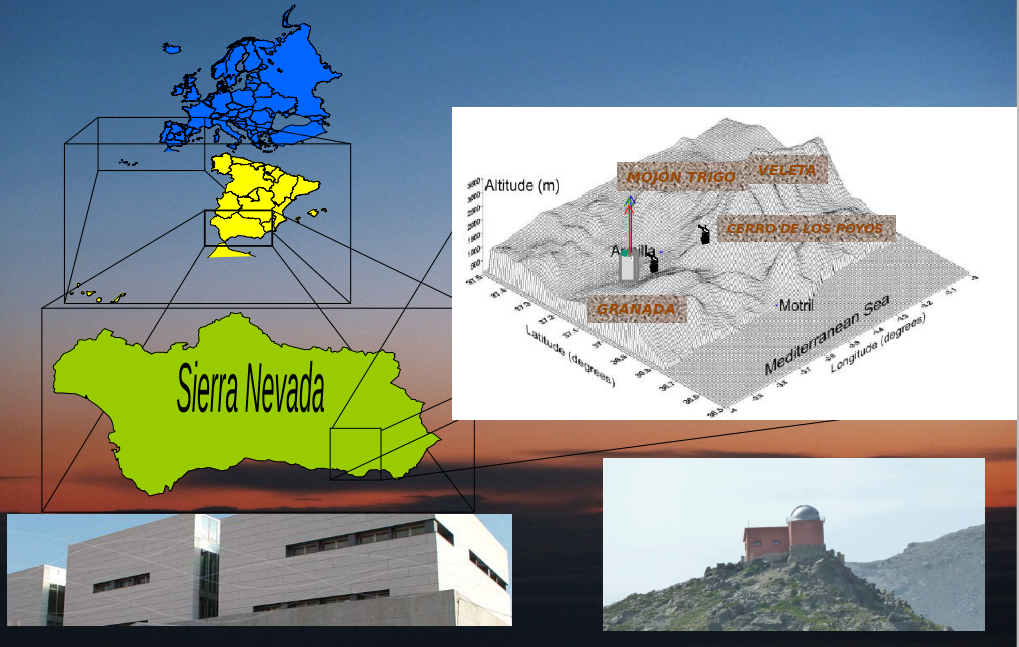The Andalusian Global ObseRvatory of the Atmosphere (AGORA) is located in Southern Spain. It consists of several experimental sites that allow the coverage of different atmospheric backgrounds: urban, rural or mountain. In addition, AGORA has a laboratory for aerosol spectroscopy research.

AGORA has been developed with the aim of performing multi-instrumental studies of atmospheric processes, with special focus on: (i) atmospheric aerosol and its role in climate and air quality, (ii) aerosol-cloud interaction processes, and (iii) active trace gases in the lowermost atmosphere layers.
The observatory operates remote sensing and in situ instruments, most of them included in the framework of ACTRIS infrastructure.
The goals defined for AGORA have been addressed by means of the combination of several measurement techniques, covering active and passive remote sensing from ground and in-situ techniques. The synergy between equipment and available methodologies allows for the characterization of optical and microphysical properties of atmospheric aerosol, from the surface, through levels within planetary boundary layer (ABL) and the free troposphere, up to the stratosphere with processes such as volcanic particle transport. Other aerosol properties can be also characterized, such as its hygroscopic growth and its behavior as a condensation nucleus, i.e., as a seed for cloud formation.
Exploration techniques available in AGORA instrumentation range from in-situ to its counterpart in remote sensing, which allows to extend studies along the atmospheric column. The advanced equipment of AGORA offers high and secure performance along the process of establishment of ACTRIS-ERIC. AGORA will offer services to the scientific community, national and international, through protocols for monitoring and access to instrumentation by researchers (physical, remote and virtual). These services are directed by transnational access programs (TNA) funded by European projects like ATMO ACCESS.
Since February 2022, AGORA has the award of Advanced Technologies Unique Laboratory, as acknowledged by the University of Granada.
AGORA observatory has three main facilities that belong to the Andalusian Institute for Earth System Research, IISTA-CEAMA of the University of Granada, and a laboratory for aerosol spectrometry research. In addition, some of the AGORA instruments are available for participation in campaigns.
(i) UGR station (UGR), located in the city of Granada (37.16ºN, 3.61ºW, 680m asl). The station characterizes urban atmospheric background, and it combines long-term monitoring of vertical distribution of atmospheric aerosol, with in-situ measurements for the characterization of aerosol particles, as well as the monitoring of clouds and atmospheric and solar radiation at several spectral ranges.
(ii) Sierra Nevada Mountain, Cerro Poyos (CP) (37.11ºN; 3.49ºW; 1830 m asl) and (iii) Sierra Nevada Station (SNS) (37.10ºN, 3.39ºW, 2500 m asl), both located at around 20km from UGR station. Their proximity offers a unique opportunity to combine the vertical remote sounding of the atmospheric column from UGR station with in-situ measurements at different altitudes in Sierra Nevada slopes. The high mountain stations allow the characterization of regional and long-range transport episodes and for the validation of inversion algorithms used to retrieve aerosol microphysical properties.

The Laboratory of Aerosol Spectroscopy, located in UGR station, is designed for the analysis of basic properties of aerosol particles. By applying techniques of confinement of individual aerosol particles, fundamental properties can be controlled, such as relative humidity, temperature, concentration of oxidizing gases, particle sizes, concentrations and composition, and even light irradiance. This allows the study of time-dependent processes. The laboratory contains state-of-the-art equipment, allowing the analysis of thermodynamic and kinetic variables of the aerosol, in the limits of classical mechanics and quantum theory. The laboratory not only allows studying processes and properties of the atmospheric environment, but also separation processes of liquid-liquid, liquid-solid, solid-solid phases in aerosol, which are key for the pharmaceutical industry.
The Laboratory of Atmospheric Geochemistry, located in UGR station, is designed for the physicochemical characterization of environmental samples. The laboratory provides various elementary tools and materials for the chemical speciation of samples such as: filter treatments for sampling atmospheric particulate matter; filtration of environmental samples; leaching methodologies; and gravimetric analysis. The laboratory contains specific laboratory equipment for the samples treatment and characterization (high-temperature oven, high-precision balance, filtration equipment, ultrapure water systems).
Research Added Value
The wide instrumentation of AGORA and the special characteristics of its geographical location and orography offer a unique opportunity to perform research in atmospheric aerosol, its role in air quality and climate, and in aerosol-cloud interaction processes.
The UGR station allows the study of local aerosols generated at the city of Granada, mainly traffic and domestic heating, including systems based on fossil fuel and biomass combustion (Titos et al., 2014, 2017; Patrón et al., 2017, Casquero-Vera et al., 2020, Casquero-Vera et al, 2021). Other important local aerosol sources in the metropolitan area are the open burning of agricultural leftovers in agricultural lands surrounding the south and west part of the city during winter, primary bioaerosol like pollen (Cariñanos et al, 2021) and the soil re-suspension due to the soil aridity in summer (Titos et al., 2014; 2017). Granada, due to its proximity to North Africa (200km), is also affected by mineral dust outbreaks from the Sahara Desert, specially frequent during spring and summer (Antón et al et al., 2012; Valenzuela et al., 2012; Cazorla et al., 2017).
The topography of Granada basin, surrounded by mountains, produces interesting effects. For example, it makes ventilation processes difficult and favours aerosol stagnation (Patrón et al., 2017) and, therefore, the accumulation of pollutants near the urban sources. It also favours the development of thermal inversions in winter (Lyamani et al., 2010; 2012; Moreira et al., 2018; 2019).
The synergy between AGORA equipment and available methodologies allows for the characterization of optical and microphysical properties of atmospheric aerosol, from the surface, through levels within planetary boundary layer (ABL) and the free troposphere, up to the stratosphere (Benavent-Oltra et al., 2020, 2021).
In the context of aerosol-cloud interaction research, AGORA instrumentation allows the research in activation properties of aerosol particles as cloud condensation nuclei (CCN) (Rejano et al., 2021).